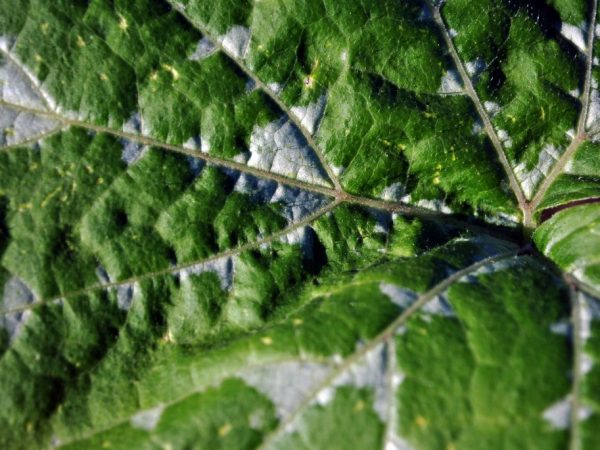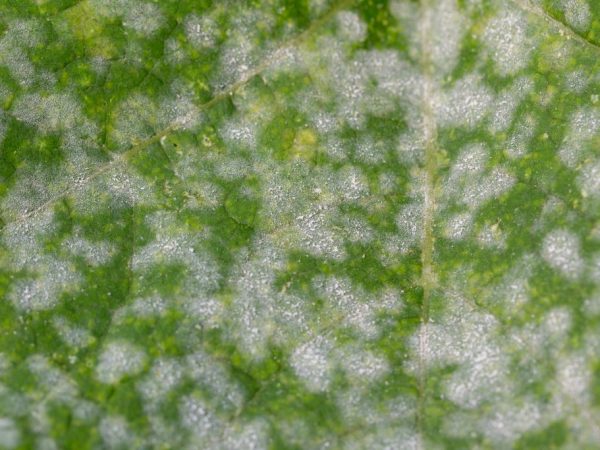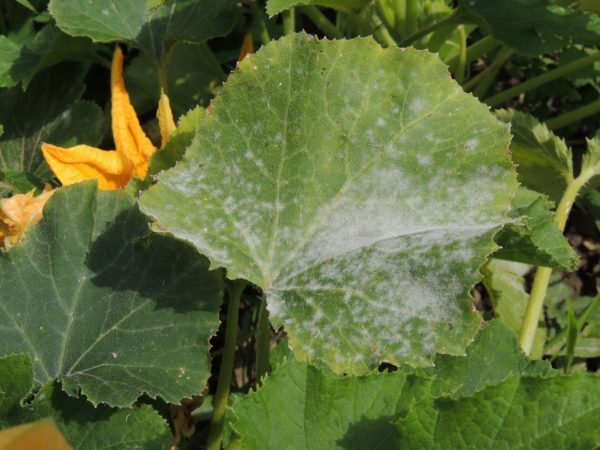Causes of white spots on zucchini leaves
White spots on the leaves of squash are a sign of a disease common in squash. They are clearly visible and cover the leaf surface in large numbers, and sometimes spread to the stem.

Causes of white spots on zucchini leaves
The main causes of white spot
White spots and plaque on squash foliage and fruits have different pathogenesis, signaling damage by a fungus or attack by a harmful insect.
Powdery mildew
One of the common reasons why the leaves of zucchini turn white is a fungal disease - powdery mildew.
It appears in conditions of high humidity and at low ambient temperatures up to 18 ° C and below.
Supersaturation of the soil with nitrogen-containing fertilizing complexes in the absence of regular watering also favors the appearance.
Downy mildew is accompanied by the appearance of yellow or brown oily fragments
After some time, the spots increase in diameter, they are gradually covered with a powdery coating, which is able to spread to the stalk of the squash.
Infected foliage withers and dies off. Damaged stems lose their elasticity, become lethargic and brittle.
When powdery mildew appears at the fruiting stage, the ripening time of vegetables is reduced, but zucchini lose their gastronomic qualities and acquire a bitter or sour taste.
Spider mite
The attack of a spider mite on the planting of zucchini is associated with high humidity when growing a vegetable crop in greenhouse and greenhouse conditions, as well as when the bushes are thickening.
The pest settles on the lower part of the foliage and in a short period of time braids it with a thin web.
The spider mite has a small oblong body up to 0.4-0.6 m in size with a light green color.
When affected by this pest, the leaves of the zucchini are covered with white specks, which after a while are transformed into spots. Later, it begins to turn yellow and eventually dies off.
In case of severe damage, the plant dies due to a violation of the process of photosynthesis.
A massive attack is observed in the summer from June to August, when the weather is stable and warm outside.
Rot

Rot appears due to temperature changes
Often, zucchini leaves turn white due to a fungal disease called Gray Rot.
The disease appears with sudden changes in temperature at night and during the day.
The favorable factors that enhance its development are the high humidity of the environment and soil and the oversaturation of the soil with nitrogen, which contributes to the active growth of green mass and thickening of the plantings.
More often, the appearance of gray rot occurs in the last days of May and the end of August.
Initially, it infects squash foliage and ovaries, causing them to die off.The spots are covered with plaque, subsequently they become moist, soften the structure of the vegetative parts of the vegetable crop, spreading to healthy specimens.
Mosaic
White mosaic also appears as white spots on the leaves of the squash, which form a mosaic pattern.
It is considered one of the most dangerous diseases of the pumpkin family.
After a short amount of time, only the veins remain green in the vegetable crop, the rest of the leaf burns out.
When damaged by a mosaic, the foliage does not undergo deformation - it does not curl and does not dry out.
Reasons for the appearance: sharp changes in water temperature during irrigation and soil soil, as well as incorrect selection of predecessors.
A fungal disease leads to a slowed down development of a vegetable crop, shrinking of stems, foliage and fruits. Vegetables are deformed, often with white stripes and outgrowths.
Fighting with chemicals
The use of chemicals in the fight against white spot on the leaves depends on the source of its occurrence.
Spider mite
For spider mites, insecticides are used: Karbofos, Fitoverm, Aktellik.
They kill the parasitic insect and effectively protect the plant for up to 2 weeks. In case of mass damage to squash plantings, it is recommended to treat the vegetable crop with insecticides in several approaches. It is not recommended to use insecticidal treatment on fruits.
Powdery mildew
In order to prevent the spread of fungal spores of powdery mildew, planting zucchini is treated with copper chloride (40 g is dissolved in 10 liters of water).
An effective action against fungus is also possessed by:
- copper sulfate (50 g per 10 l);
- Topaz (2 ml per 10 liters of water);
- Fitosporin (5 g per 10 l of water).
From gray rot

Fungicides will get rid of the problem
In the fight against gray rot on zucchini, fungicidal preparations such as Rovral and Bayleton are used with the simultaneous fertilization of vegetable crops with organic matter and ready-made mineral complexes.
From the mosaic
It is impossible to eliminate the viral white mosaic as it is not treatable.
To prevent it from appearing, preventive measures are needed.
Traditional methods of treatment
Folk remedies in the fight against the causes of the appearance of white bloom and stains on zucchini are an effective alternative to chemistry.
Spider mite
The following are effective against the parasitic insect:
- laundry soap in solution (100 g per 10 l of water) for washing foliage;
- onion husks in infusion (500-700 g per 10 liters of water are boiled and infused for 8-12 hours) for spraying;
- garlic in infusion (5-6 heads of garlic for 4-5 liters of water, infused for 4 hours) for spraying;
- tobacco in infusion (40 g per 1 liter is kept for 2 days) for spraying.
Powdery mildew
Folk remedies help to cope with powdery mildew:
- soda ash, on the basis of which a working solution is made: mix 25 g of soda, 5 liters of water and 1 tbsp. soap. Zucchini is sprayed with this composition, it is recommended to process it 2-3 times with an intermediate interval of 8-10 days;
- iodine (1 ml) in combination with milk (1 l) and water (9 l). The solution is sprayed on the affected areas with an intermediate interval of 14 days.
From gray rot
Milk whey helps to get rid of gray rot (1 liter of sour milk product for 3 liters of water is insisted for 3-4 hours). Used for spraying.
From the mosaic
Cope with white mosaic folk remedies is problematic. The main measure against fungus is the replacement of soil.
Preventive measures
Preventive measures help prevent disease and pest damage to squash and avoid white spots and plaque on their leaves.
The main preventive measures:
- regular weeding with careful removal of weeds;
- observance of crop rotation with the correct selection of predecessors and a change in the planting site of zucchini annually;
- feeding vegetable crops with drugs that increase resistance to diseases and pests; maintaining the required level of moisture in the soil and the environment, especially in greenhouses and greenhouses;
- watering plantings with water at room temperature;
- pre-sowing disinfectant treatment of seed material.

